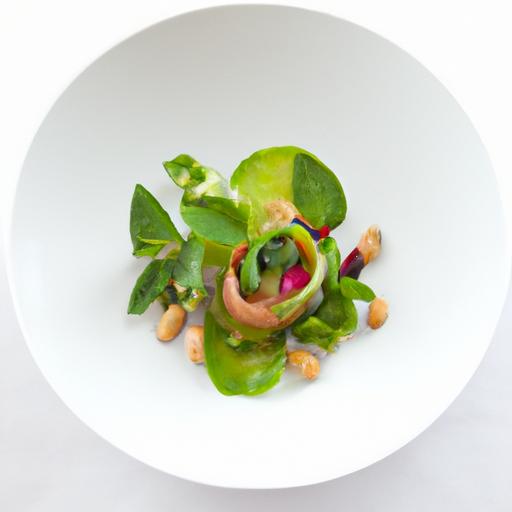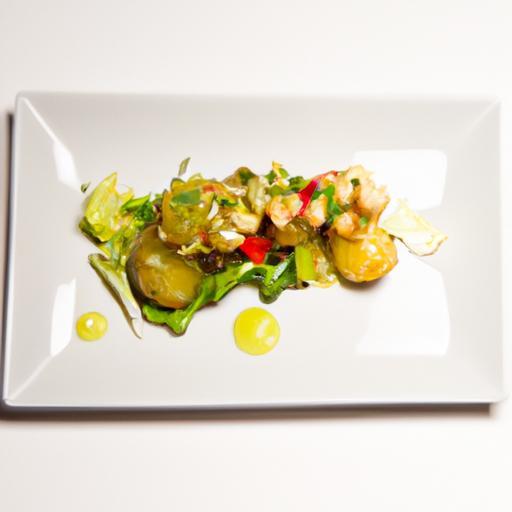In the intricate symphony of life, few molecules play a role as captivating and versatile as glutamic acid. Often lurking behind the scenes, this remarkable building block is a key architect in the brain’s communication network and an unsung hero in the world of taste. From sparking neural connections to igniting savory sensations on the palate, glutamic acid is a molecule that bridges science and sensory delight. Join us as we unveil the secrets of glutamic acid, exploring how this humble amino acid shapes the essence of thought and flavor in ways both profound and delicious.
Glutamic Acid’s Role in Elevating Flavor and Brain Health: A Savory Umami Mushroom Risotto
Glutamic Acid stands as a fascinating nexus between the culinary world and cognitive wellness, celebrated for its dual role as a neurotransmitter and a natural flavor enhancer. This Savory Umami Mushroom Risotto is a perfect dish to explore both the science and the soul of glutamic acid, showcasing how foods rich in this amino acid can elevate taste complexity while supporting brain function.
Prep and Cook Time
- Preparation: 15 minutes
- Cooking: 35 minutes
- Total Time: 50 minutes
Yield
Serves 4 hearty portions
Difficulty Level
Medium – Ideal for cooks comfortable with attentive stirring and timing
Ingredients
- 1 ½ cups Arborio rice, rinsed and drained
- 4 cups low-sodium vegetable broth, kept warm
- 1 cup shiitake mushrooms, sliced
- 1 cup cremini mushrooms, sliced
- ½ cup finely chopped onions
- 3 cloves garlic, minced
- 3 tbsp extra virgin olive oil
- ½ cup dry white wine
- ¼ cup grated Parmesan cheese
- 2 tbsp unsalted butter
- 1 tbsp soy sauce (adds natural glutamates)
- Salt and freshly ground black pepper, to taste
- 2 tsp fresh thyme, finely chopped
- Fresh parsley, chopped for garnish
Instructions
- Heat olive oil in a large sauté pan over medium heat. Add onions and garlic, sauté until fragrant and translucent, about 3 minutes.
- Add shiitake and cremini mushrooms; sauté until golden and tender, approximately 7 minutes, stirring occasionally to release their natural glutamic acid-rich umami flavor.
- Pour in the Arborio rice, stirring to coat each grain with the aromatic mixture for 2 minutes, allowing the rice to toast slightly.
- Add the white wine, stirring until it evaporates almost completely to build depth in flavor.
- Begin adding the warm vegetable broth, one ladle at a time, stirring constantly. Wait until the liquid is nearly absorbed before adding the next ladle. This slow addition process encourages creamy starch release.
- After about 25 minutes and the rice is al dente, stir in soy sauce, butter, Parmesan cheese, and thyme. Adjust seasoning with salt and black pepper to taste-the soy sauce enhances the umami without overpowering.
- Remove from heat, cover for 2 minutes to allow flavors to meld perfectly.
- Serve hot, garnished with fresh parsley and an extra sprinkle of Parmesan if desired.
Tips for Success
- Use a warm broth throughout cooking to maintain consistent temperature and proper rice texture.
- Stir regularly but gently to avoid breaking rice grains and to coax out creamy starch.
- For a vegan alternative, substitute Parmesan and butter with nutritional yeast and coconut oil respectively.
- The selection of mushrooms is key: shiitake and cremini provide robust natural glutamates. Experiment with dried porcini soaked in hot water for an even more intense umami punch.
- This risotto tastes even better the next day; refrigerate leftovers and reheat slowly with a splash of broth to preserve creaminess.
Serving Suggestions
Plate this risotto in shallow bowls to showcase its creamy texture and inviting colors. Pair with a crisp green salad dressed with lemon vinaigrette for contrast. A light white wine such as Pinot Grigio complements the earthy mushrooms and enhances the glutamic acid’s flavor profile. For garnish, fresh parsley or chives add a splash of color and fresh herbal notes.
| Nutrient | Amount Per Serving |
|---|---|
| Calories | 370 kcal |
| Protein | 11 g |
| Carbohydrates | 55 g |
| Fat | 9 g |

To further explore the impact of glutamic acid in diet and brain health, visit this comprehensive review by NCBI. Additionally, discover more umami-rich recipes to delight your palate and your mind.
Q&A
Q&A: Glutamic Acid Unveiled – The Building Block of Brain & Flavor
Q1: What exactly is glutamic acid?
A1: Glutamic acid is a naturally occurring amino acid, a fundamental building block in the proteins that make up our body. Think of it as a versatile maestro, orchestrating both the structure of life and the symphony of savory flavors on your palate.
Q2: How does glutamic acid affect the brain?
A2: In the brain, glutamic acid transforms into glutamate, a vital neurotransmitter. It acts like an energizing spark, helping neurons communicate rapidly and efficiently. This makes it essential for learning, memory, and overall mental agility.
Q3: Why is glutamic acid called the ‘flavor enhancer’?
A3: Glutamic acid is the secret behind umami-the rich, savory taste that makes foods like mushrooms, aged cheese, and soy sauce irresistible. It activates special taste receptors, turning your eating experience from ordinary to extraordinary.
Q4: Is glutamic acid the same as MSG?
A4: Not exactly. MSG, or monosodium glutamate, is the sodium salt of glutamic acid. It’s a purified, concentrated form used widely as a seasoning. While glutamic acid naturally occurs in many foods, MSG is a manufactured enhancer that amplifies umami.
Q5: Can glutamic acid impact health positively?
A5: Absolutely! Besides boosting brain function and flavor, glutamic acid supports metabolism and serves as a building block for antioxidants. However, as with all things, moderation is key to maintaining a balanced diet.
Q6: Where can we find glutamic acid in nature?
A6: Glutamic acid is abundant in protein-rich foods-think meats, dairy, nuts, and certain vegetables like tomatoes and seaweed. Fermented foods also pack a powerful glutamic punch, thanks to their natural production processes.
Q7: How does glutamic acid influence cooking and culinary arts?
A7: Chefs treasure glutamic acid for its ability to deepen flavors and create mouthwatering umami notes. Whether it’s slow-cooked stocks, fermented sauces, or aged cheeses, glutamic acid is the invisible hand guiding taste buds to delight.
Q8: Should people be cautious about glutamic acid intake?
A8: For most, it’s perfectly safe and beneficial. Some individuals report sensitivity to high amounts of MSG, but naturally occurring glutamic acid in foods rarely causes issues. Listening to your body and opting for balanced meals is the best approach.
Q9: How does glutamic acid fit into the bigger picture of nutrition and neuroscience?
A9: As a bridge between food chemistry and brain science, glutamic acid epitomizes the intersection of nutrition and mental wellbeing. It reminds us that what we eat not only fuels our bodies but also shapes our minds in delicious, dynamic ways.
Q10: What’s the ultimate takeaway about glutamic acid?
A10: Glutamic acid is more than just a molecule-it’s a vital connector between biology and flavor. By appreciating its roles, we gain insight into how the brain learns, how food satisfies, and how life’s complexity unfolds one amino acid at a time.
The Conclusion
As we close the chapter on glutamic acid, it’s clear that this humble amino acid is far more than just a chemical compound-it is a master key unlocking the secrets of both our palate and our mind. From enhancing the savory depths of our favorite dishes to acting as a vital neurotransmitter shaping memory, learning, and mood, glutamic acid stands at the fascinating crossroads of flavor and neuroscience. By appreciating its dual role, we gain not only a deeper understanding of what tantalizes our taste buds but also the intricate biochemical symphony that powers our brains. So next time you savor that umami-rich bite or find yourself immersed in a moment of mental clarity, remember: glutamic acid is quietly at work, weaving together the essence of taste and thought.


